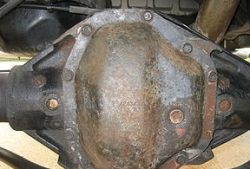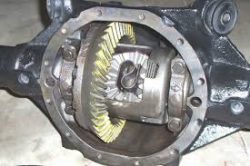
Understanding your car’s rear end – a key segment of your vehicle’s drivetrain – is essential for proper maintenance and troubleshooting.
Key Takeaways
- The rear end of a car is also known as the rear differential.
-
There are various types of differential. Including open, limited-slip, locking, electronic, and torque-vectoring adjust to driving conditions and needs.
-
Identifying rear end issues is essential. Symptoms include odd noises, vibrations, overheating, steering challenges, and gear grinding. Regular inspections and maintenance, such as differential oil changes, are key to longevity and performance.
-
Simple maintenance may be DIY-friendly, but complex repairs are best left to professionals. If you need help with your differential, contact us today and let us know how we can help
What is a car’s rear end?
A rear end, which is the colloquial term for a car’s rear differential, earns its name from its position at the back, or “rear,” of the vehicle. So what does a rear differential do? This critical component handles delivering power from the engine to the rear wheels. It also enables the wheels to rotate at different speeds.
Parts of a differential
Now, let’s examine the differential, a critical component in a vehicle’s drivetrain. The differential consists of several integral parts, such as the pinion gear, ring gear, carrier assembly, and spider gears. Its location varies depending on the vehicle’s drivetrain configuration. The differential can be at the front, rear, or center for all-wheel and four-wheel drive systems.
The primary function of the differential is to allow the wheels to rotate at different speeds. The rotation at different speeds is essential for smooth and safe cornering. This capability is important when a vehicle is turning, as the inside wheels travel a shorter distance than the outside wheels.
Pinion drive gear
The pinion gear is a critical component within the differential. It is a gear that meshes with the ring gear to send power from the driveshaft to the axle shafts. The engagement between the pinion gear and the ring gear is a key step in changing the direction of power flow by 90 degrees, which is essential for the wheels to receive power and rotate.
This gear is pivotal in the power transmission process of the vehicle’s drivetrain. The pinion gear is an important element that ensures the effective operation of a vehicle’s differential system.
Ring gear
If the pinion gear is considered the primary driver in the power transmission process, then the ring gear serves as the central distributor. It takes power from the pinion gear and allocates it to the axle shafts. The ring gear collaborates with the pinion gear to modify and transmit rotary motion and torque. It ensures that power is delivered to the axle with a precise speed ratio. This is critical for the differential’s operation.
Differential case
The differential case, also known as the carrier, is a fundamental component of a vehicle’s drivetrain system. It securely encases the intricate network of gears. This is to maintain their alignment and help their primary function—to enable differential wheel speeds during vehicular maneuvers.
The differential case’s role is like a track-and-field relay where athletes on the inner track run a shorter distance than those on the outer track. Similarly, the differential allows the inner wheels of a car to rotate at a slower rate compared to the outer wheels while cornering.
Spider gears and side gears
Now, let’s examine the Spider gears and side gears. These are integral components of the differential. They enable the wheels to rotate at varying speeds during cornering. The Spider gears, referred to as satellite gears, are responsible for transferring rotational force from the driveshaft to the axles and wheels. The side gears, also known as axle gears or planetary gears, engage with the Spider gears to allow the differential action that allows for the difference in wheel rotation speeds.
These gears are essential for the differential to perform its function. They provide a smoother driving experience by allowing each wheel to move independently of the others during turns, thus preventing tire slippage and enhancing vehicle handling.
Differential housing
The differential housing, often simply referred to as the diff housing, performs a critical function within the vehicle’s drivetrain. It encases the differential gear assemblies and endures the mechanical stresses exerted by the gears. The differential housing is constructed from robust materials such as ductile cast iron or aluminum. It is engineered to support different propulsion systems and withstand the rigours of driving.
Considering its role in vehicle safety and performance, the differential housing’s design and material choice is vital for its durability. It also affects the ability to protect the internal components of the differential. For example, external contaminants and damage. When navigating through challenging road conditions, including potholes and rough terrain, the integrity of the differential housing is paramount in shielding the vehicle’s differential gears.
Axle housing
The axle housing is a structural component designed to encase and shield the axle shafts and the differential. Its robust construction not only supports these internal components but also plays a critical role in transferring power from the engine to the wheels. Additionally, the axle housing bears the vehicle’s weight, absorbs road shocks, and forms an integral part of the vehicle’s framework, ensuring the durability and reliability of the drivetrain system.
Axle shafts
The axle shafts, also known as CV axles or half-shafts, are critical components of the vehicle’s drivetrain. They are responsible for conveying the rotational force from the differential to the wheels, enabling the vehicle to move. These shafts must be robust to support the substantial weight of the vehicle, as well as any additional load from passengers and cargo. Their design and construction are crucial for the drivetrain’s efficiency and the vehicle’s overall performance, ensuring reliable transmission of power under varying driving conditions.
Types of differentials
Let’s take a closer look at the different types of differentials. Each type has a unique way of managing the torque and rotational speed of the vehicle’s wheels. From the popular open differential found in most family sedans to the limited-slip differential common in sports cars, each has its own set of advantages and challenges. Some common types of differentials include:
-
Open differential
-
Limited-slip differential
-
Electronic limited-slip differential
-
Torque-vectoring differential
Understanding the differences between these types of differentials can help you choose the right one for your vehicle and driving needs.
And let’s not forget the locking differential, the favorite among off-roaders for its ability to tackle uneven terrain. Sounds interesting, right? Let’s delve deeper.
Open differential
The open differential is a common sight in most family sedans and economy cars. It has the following features:
-
It distributes engine torque evenly
-
It allows the wheels to rotate at different speeds
-
It is especially useful during cornering, allowing wheels to turn at different rates to prevent wheel hop and excessive tire wear.
However, its performance on uneven or slippery surfaces might not be as good, as it tends to send torque to the wheel with less resistance. But for most city drivers, the open differential is more than sufficient.
Locking differential
If you’re an off-road enthusiast, you’re probably familiar with the locking differential. This type allows the wheels to turn at different speeds most of the time, but when its locking function is activated, the wheels both turn at the same speed. This feature is particularly useful when one wheel is off the ground or on a low traction surface.
So, if you’re planning to venture off the beaten path, a locking differential might be your best friend.
Limited-slip differential
The limited-slip differential is a star in the world of performance driving. It functions like an open differential under normal conditions but can transfer torque to the wheel with more traction when slip is detected. This feature enhances acceleration and cornering stability, reducing the chances of understeer or oversteer.
Torque-vectoring differential
The torque-vectoring differential allocates more power to the outer wheels during a turn, pushing the vehicle into the curve and reducing understeer. This feature is often found in high-performance cars, such as the Audi RS 3 and Ferrari SF90 Stradale.
While it might not be noticeable in regular driving conditions, it can make a significant difference in performance driving.
Torsen differential
Next up is the Torsen (TORque SENsing) differential. It’s a type of limited-slip differential that uses gears instead of clutches to provide torque to the wheels. Unlike some other types of differentials, Torsen differentials are mechanical, which means they don’t need regular maintenance.
However, they do have their limitations. For instance, when a wheel is off the ground, a Torsen differential acts like an open differential, limiting torque to the axle.
Active differential
This is a computer-controlled differential that adjusts torque distribution based on driving conditions. It includes mechanisms similar to those in a limited-slip differential, providing resistance to transfer torque from one side of the vehicle to the other. However, it integrates electronic activation of these mechanisms rather than relying solely on mechanical force.
This type of differential is especially favored in rally racing due to its ability to quickly adapt to varied and rapidly changing driving conditions.
Diagnosing Rear End Issues
Rear end issues can be detected through an array of common symptoms, each potentially indicating different problems within the system. Some common symptoms to look out for include:
-
Unusual noises
-
Overheating
-
Steering problems
-
Gear grinding
Each symptom may be related to a different component within the rear end.
Thus, it’s crucial to conduct a diagnostic process with attention to details or consult with a professional for accurate identification and repair, ensuring the need to replace any faulty components is addressed.
Signs of Worn or Damaged Rear End Components
One of the first signs of a problem with your car’s rear end is unusual noises. A failing differential can produce whining or whirring sounds during acceleration, deceleration, or cornering. Another sign to look out for is increased vibrations from the rear of the vehicle, particularly upon acceleration.
And let’s not forget leaks in rear end components, such as those from axle housings or differential gear oil. These are clear indicators of potential problems and a sign that inspection and repair may be necessary.
Tips for Maintaining Your Car Rear End
Keeping your car’s rear end in good condition is not just about identifying and fixing problems. It’s also about prevention. Regular inspections, maintenance, and proper driving habits can go a long way in keeping your rear end components running smoothly.
Let’s delve into some tips to help you maintain your car’s rear end and avoid costly repairs down the line.
Regular Inspections and Maintenance
One of the best ways to keep your car’s rear end in top shape is by conducting regular inspections and maintenance. This includes changing the differential oil regularly to prevent wear and maintain all parts in good condition. Routine checks and changes of differential oil are recommended every 30,000 to 60,000 miles, depending on your vehicle’s requirements. You can find the correct interval in your vehicle’s manual.
Also, remember to conduct regular driveline inspections to ensure the operational integrity of your vehicle.
When to Seek Professional Help
Some minor issues can be fixed by car owners themselves. However, complex differential repairs that go beyond routine maintenance or standard replacements should be handled by a professional. In cases where car owners are unsure about the nature of the rear end problem, it’s advisable to have a skilled mechanic inspect and address the issue.
At Houston Rebuilt Axles, our team specializes in both axle repairs and differential repairs and differential rebuilds. We also remanufacture differentials. Contact us today and let us help you with your differential issues.

